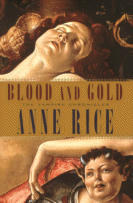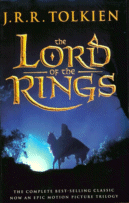Fantasy Book Reviews
Page One of TwoBlood and Gold (Vampire Chronicles) by Anne Rice
Knopf, Oct., 2001Hardcover, 460 pages
ISBN: 0679454497
Ordering information:
Amazon.com
 The ancient and scholarly vampire Marius has figured
prominently in other Vampire Chronicles, but
we have never heard his full story from his own lips
until now. Marius befriends a vampire, Thorne, who
has lain asleep beneath the ice in the frozen North for
hundreds of years. After giving Thorne clothing, food
and a place to stay, he acquiesces to his guest's
request to hear his life story. And what a story it is.
Made a vampire against his will when he was a respected
Roman senator, Marius is bitterly angry and disillusioned
by what happened to him. After he was made a vampire,
he was sent to Egypt to guard the "Parents,"
the eldest vampires in whom rests the soul of the "Blood Gods."
Marius' story takes us through some familiar ground
seen before in other Vampire Chronicles, but
brings a new perspective to some old events. Marius
is an introspective and yet emotional storyteller.
He shares with us his
fury at being taken from his life as a human,
his passion for Pandora and his despair for losing her,
his years as mentor for the Vampire Lestat and his
continual run-ins with the vampires who have dedicated
their lives to worshipping Satan (Marius himself only
feeds upon criminals).
The ancient and scholarly vampire Marius has figured
prominently in other Vampire Chronicles, but
we have never heard his full story from his own lips
until now. Marius befriends a vampire, Thorne, who
has lain asleep beneath the ice in the frozen North for
hundreds of years. After giving Thorne clothing, food
and a place to stay, he acquiesces to his guest's
request to hear his life story. And what a story it is.
Made a vampire against his will when he was a respected
Roman senator, Marius is bitterly angry and disillusioned
by what happened to him. After he was made a vampire,
he was sent to Egypt to guard the "Parents,"
the eldest vampires in whom rests the soul of the "Blood Gods."
Marius' story takes us through some familiar ground
seen before in other Vampire Chronicles, but
brings a new perspective to some old events. Marius
is an introspective and yet emotional storyteller.
He shares with us his
fury at being taken from his life as a human,
his passion for Pandora and his despair for losing her,
his years as mentor for the Vampire Lestat and his
continual run-ins with the vampires who have dedicated
their lives to worshipping Satan (Marius himself only
feeds upon criminals).
Through his eyes, we see the fall of Rome, the rise of Christianity, the beauty of the Renaissance, and the rise of technology. Anne Rice is quite a scholar, spending months in research on a particular period or subject, and her love for history is evident in her books. Her skill at painting a lush and sensual vision of times long passed is in full force here. There is passion, love and great loss in Marius' moving and compelling story. Rice's devoted fans are in for a special treat with this one. Highly recommended.
The Lord of the Rings: One Volume Edition by J.R.R. Tolkien
Houghton Mifflin, Nov., 2001Trade paperback, 1137 pages
ISBN: 0618129022
Ordering information:
Amazon.com
 With the release of the new Lord of the Rings trilogy,
Tolkien is now highly fashionable again. But for readers
who have loved and reread this magnificent series
over the years, it never really went out of style at all.
For those who have somehow avoided being exposed
to Tolkien, the basic plot of the story is as follows:
Hobbit Frodo Baggins inherits a mysterious gold
ring from Bilbo Baggins (the hero of the enchanting
prelude, The Hobbit). The ring is actually the
one ring of power, forged by Morgoth with the
unwitting help of the High Elves long ago.
The one ring rules the three lesser rings, which
bring all the beauty and magic to Middle Earth.
The one ring itself is pure evil, and is now
coveted by the evil Sauron, a lesser servant of
the vanquished Morgoth. Sauron knows that the
one ring has reappeared in Middle Earth (it was won
during a riddling game by Bilbo Baggins in the
first book in the series, The Hobbit). The ring must
be destroyed, and so a fellowship of nine companions
sets out to take the ring to Mount Doom, the only
place with a fire hot enough to melt the ring.
The companions include the hobbits, Frodo,
Sam, Merry and Pippin, Legolas the Elf,
Gimli the Dwarf, Boromir, eldest son of Denethor II, the Stweward
of Gondor,
Aragorn, the heir to Isildur's throne, and
the powerful wizard, Gandalf the Grey. The trilogy follows
the path of the fellowship, as they meet incredible
adventures and face terrible trials along the way.
With the release of the new Lord of the Rings trilogy,
Tolkien is now highly fashionable again. But for readers
who have loved and reread this magnificent series
over the years, it never really went out of style at all.
For those who have somehow avoided being exposed
to Tolkien, the basic plot of the story is as follows:
Hobbit Frodo Baggins inherits a mysterious gold
ring from Bilbo Baggins (the hero of the enchanting
prelude, The Hobbit). The ring is actually the
one ring of power, forged by Morgoth with the
unwitting help of the High Elves long ago.
The one ring rules the three lesser rings, which
bring all the beauty and magic to Middle Earth.
The one ring itself is pure evil, and is now
coveted by the evil Sauron, a lesser servant of
the vanquished Morgoth. Sauron knows that the
one ring has reappeared in Middle Earth (it was won
during a riddling game by Bilbo Baggins in the
first book in the series, The Hobbit). The ring must
be destroyed, and so a fellowship of nine companions
sets out to take the ring to Mount Doom, the only
place with a fire hot enough to melt the ring.
The companions include the hobbits, Frodo,
Sam, Merry and Pippin, Legolas the Elf,
Gimli the Dwarf, Boromir, eldest son of Denethor II, the Stweward
of Gondor,
Aragorn, the heir to Isildur's throne, and
the powerful wizard, Gandalf the Grey. The trilogy follows
the path of the fellowship, as they meet incredible
adventures and face terrible trials along the way.
The Lord of the Rings has been hailed as one the best books of the 20th century by some critics, and derided as escapist fantasy by others. I fall into the former category. Professor Tolkien's work is infused with the longing for things past and the lamentation for the destruction of the natural beauty of our planet caused by the Industrial Revolution and the rise of technology. An Oxford professor of Old English and medieval literature, and ardent philologist, Tolkien created two entirely new languages for the series; Sindarin, spoken by the Wood-elves and loosely modeled on Welsh, and Quenya, the language of the Light-elves, based on Latin and Finnish influences. The world of Middle Earth is similar to England, but it is an England of long ago, with the addition of all of the Anglo-Saxon mythology fully intact -- including forests that can move and talk, orcs, elves, dwarves and goblins. Tolkien's love of language shines through clearly in his powerful and moving descriptions: from the bucolic beauty of the Shire to the ethereal Lothlorièn, the home of Galadriel and Celeborn, to the evil, loud, mechanized and polluted realm of Mordor, home of Sauron. The text is liberally sprinkled with original poetry and songs, ranging from the simple folk tunes to the delicate poetry of the High Elves. But lest one think that this is a purely intellectual exercise in philology, there is enough danger, excitement and suspense here to satisfy the most discriminating fantasy and thriller fans.
Tolkien was remarkably ahead of his time. A devoted Catholic, in 1920s England would hardly be expected to have such a strong character, such as the warrior princess Eowyn of Rohan, who defies orders and sneaks into battle dressed as a man, or Galadriel, who clearly wears the pants in Lothlorièn (her husband Celeborn usually sits quietly in the background). The strong friendship between Frodo and Sam Gamgee echoes the relationship of a knight and his squire, or a soldier and his servant in wartime (Tolkien himself was present at the devastating battle of the Somme during World War I in which the British were slaughtered. Tolkine lost two of his closest friends in the war; in fact the book's anti-war themes were picked up on immediately by the 1960s counterculture.) The Lord of the Rings trilogy (The Fellowship of the Ring, The Two Towers and The Return of the King) has dark themes and overtones, certainly more so than the lighthearted prelude, The Hobbit. But there is also a gentle humor and a rapier wit, and even an underlying romance which pervades this timeless story, which many credit for beginning the entire fantasy genre which is so popular today. One can see of Tolkien's influence in the works of writers from Terry Brooks to J.K. Rowling.
There is truly something for everyone in Tolkien's work. For the Tolkien novice, I recommend first reading The Hobbit. Although it is a lighter, fun tale, it lays the groundwork for many of the events in The Lord of the Rings. And after one has read the trilogy, then I would recommend diving into The Silmarilion, the prequel to The Hobbit. The Silmarilion is more of a history text about the rise and fall of the elves, and some find it a more difficult read than the rest of the books. (Interestingly enough, The Silmarilion was Tolkien's favorite book; he once said he first created the language, then the surroundings, and then the stories of the characters.)
A timeless classic, The Lord of the Rings, is truly a must-read. Highly recommended.
--Claire E. White
Fantasy/SF/Horror Reviews
Page One | Page Two
Return to Book Reviews Index
More from Writers Write
